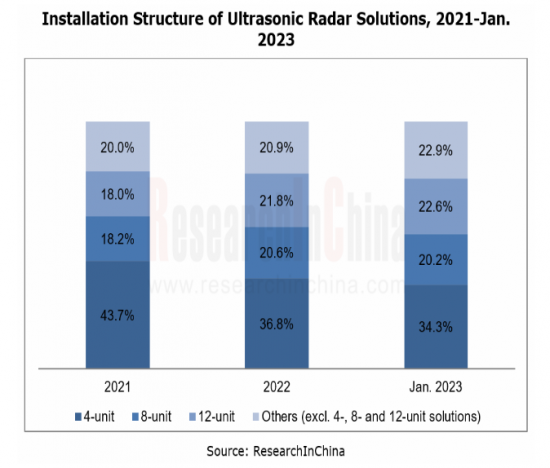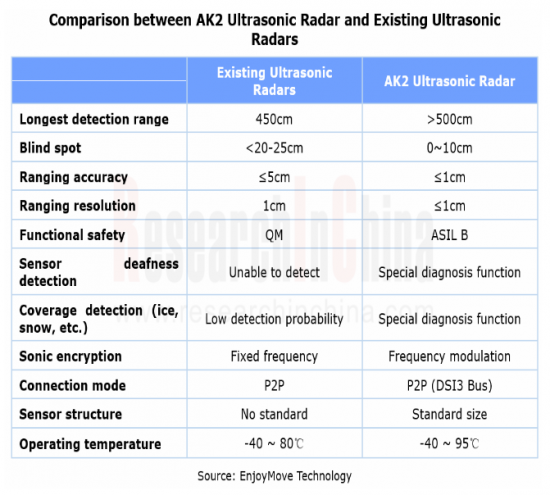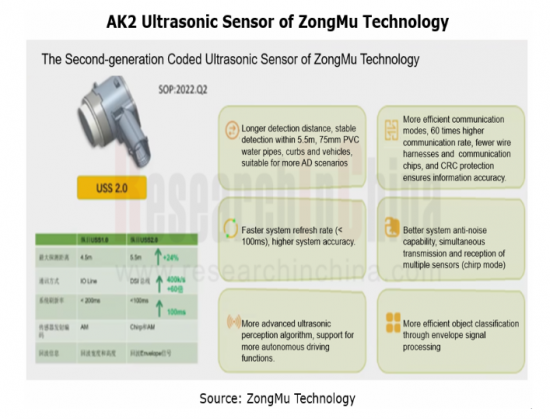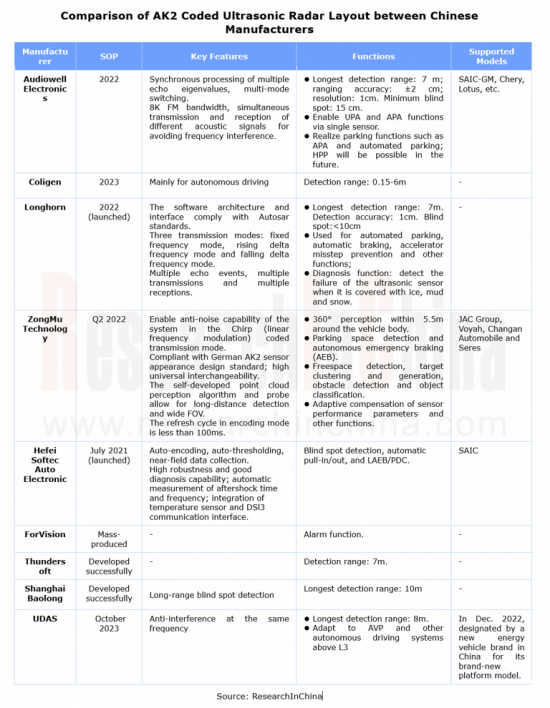 |
市场调查报告书
商品编码
1259762
汽车超音波雷达和OEM的停车解决方案的开发蓝图:2023年Automotive Ultrasonic Radar and OEM Parking Roadmap Development Research Report, 2023 |
||||||
中国的新车小客车搭载的超音波雷达数,从2021年的1亿9万台,2022年与前一年同期比较增加到7.4%的1亿752万5,000台,此外,预计2025年超越1亿4,000万台。从2021年到2023年1月,1台车辆搭载的超音波雷达数从4.9台增加到5.6台。
本报告提供超音波雷达的汽车的搭载与OEM的停车解决方案的开发趋势调查,汽车超音波雷达概要,中国的搭载数,超音波雷达解决方案的比较,主要OEM,国内外的汽车超音波雷达企业的停车解决方案的措施等彙整资讯。
目录
第1章 汽车超音波雷达搭载情境
- 汽车超音波雷达概要
- 概要、特征
- 系统配置、运行原理
- 主要的种类
- 技术解决方案
- 产业链
- 搭载情境
- 汽车超音波雷达的停车情境
- 停车功能的开发的变化
- 自动停车辅助(APA)
- 遥控停车协助 (RPA)
- 家庭地带停车飞行员 (HPP)
- 行车线模仿后退支援系统 (LRAS)
- 自动排球停车 (AVP)
- 高速公路侧面协助
第2章 中国的汽车超音波雷达搭载、解决方案的比较
- 给中国的小客车的超音波雷达的搭载数
- 搭载总数的变化
- 搭载数的变化: 中国的独立型/合资企业/新兴汽车厂商
- 搭载数的变化: 各价格
- 搭载数的变化:各品牌
- 每车辆的搭载数的变化:全体、中国独立型/合资企业/新兴汽车厂商
- 每车辆的搭载数的变化: 各价格
- 超音波雷达的搭载数方案:各搭载数
- 超音波雷达的搭载数方案:各自动驾驶等级
- 超音波雷达的搭载数方案:低/中/高结构模式
- 销售额前20名模式:搭载数4台
- 销售额前20名模式:搭载数8台
- 销售额前20名模式:搭载数12台
- 客车超音波雷达解决方案的比较
第3章 中国的汽车超音波雷达和停车的开发趋势
- 趋势1
- 趋势2
- 趋势3
- 趋势4
- 趋势5
- 趋势6
- 趋势7
- 趋势的考察:超音波雷达将取代毫米波雷达吗
第4章 OEM的停车的道路和超音波雷达的搭载方案
- OEM各公司的小客车停车解决方案概要
- BMW
- Mercedes-Benz
- Ford
- GM
- Honda
- Volkswagen
- Great Wall Motor
- Changan Automobile
- Geely
- FAW Hongqi
- GAC Aion
- BAIC
- BYD
- Dongfeng Motor
- Xpeng Motors
- NIO
- Li Auto
- Weltmeister
- Neta Auto
第5章 海外的汽车超音波雷达企业
- Bosch
- Valeo
- Continental
- Nicera
- Murata
- Denso
- Hyundai Mobis
第6章 中国的汽车超音波雷达企业
- Audiowell
- Coligen
- Longhorn Automotive Electronic Equipment
- TungThih Electronic
- Hangsheng Electronics
- ZongMu Technology
- Whetron Electronics
- Softec
- Hikvision
- ForVision
- Suzhou UDAS
- Baolong Automotive
- Shunhe Electric Technology
- Chongqing Guangda Industrial
- Ubidriving
Automotive Ultrasonic Radar Research: as a single vehicle is expected to carry 7 units in 2025, ultrasonic radars will evolve to the second generation.
As a single vehicle is expected to pack 7 units in 2025, ultrasonic radars will take the fast lane.
According to the statistics of ResearchInChina, the ultrasonic radars installed in new passenger cars in China swelled by 7.4% year on year from 100.09 million units in 2021 to 107.525 million units in 2022. It is expected that the installation will exceed 140 million units by 2025. From 2021 to January 2023, there were an increasing number of ultrasonic radars installed in a single vehicle, up from 4.9 units to 5.6 units. Thanks to factors such as large-scale application of driving and parking integration, and the integration of cockpit and parking, it is expected that ultrasonic radars per vehicle will rise to 7 units in 2025, and the ultrasonic radar market will enjoy a boom.

In terms of installed solutions, in 2022, 36.8%, 20.6% and 21.8% of new passenger cars in China carried 4-, 8- and 12-ultrasonic radar solutions, respectively; AVP used 12-ultrasonic radar solutions. In 2022, 28,804 vehicles with AVP were sold, rocketing by 589% on the previous year.

Ultrasonic radars evolve to the second generation - AK2 ultrasonic radar.
Amid the growth in installations and demand, ultrasonic radar technology is also advancing, and has iterated to AK2 ultrasonic radar. Compared with conventional ultrasonic radars, AK2 ultrasonic radar offers the following benefits:
- Longer detection range (>5m), smaller blind spot (<10cm).
- More echoes: DSI3 communication mode is adopted, providing the highest rate of signal propagation, up to 444kbit/s; at most 230 echoes can be supported in a sensor detection cycle.
- Anti-interference
- ASIL-B
- Waveform coding
- Multi-mode switching (for example, Longhorn AK2 supports three transmission modes: fixed frequency mode, rising delta frequency mode and falling delta frequency mode)
- Diagnosis function (for example, Bosch's sixth-generation ultrasonic radar can detect hardware deafness).

Regarding the AK2 layout, foreign manufacturers started earlier than Chinese companies. In 2016, Bosch successfully developed the sixth-generation ultrasonic radar, which combines digital signals and signal codes together and enables sensors to achieve multiple receptions and multiple transmissions through a linear frequency. Continental's full-stack solution based on its CUS3 ultrasonic sensor (with longest detection range of 5.5m, and self-diagnosis capability) is planned to be produced in quantities in 2024. The next-generation products of Murata Manufacturing can be used together with the ElmosE 524.17 driver chip to support frequency conversion (coding), with the blind spot only covering 15cm, and the longest detection range of 5.5m.
In China, both Audiowell Electronics and ZongMu Technology mass-produced AK2 radar in 2022; Coligen and Suzhou UDAS plan mass production in 2023; the rest companies are developing or have successfully developed AK2 radar.
Among them, the second-generation coded ultrasonic sensor of ZongMu Technology meets the German AK2 sensor appearance design standard. Through the Chirp (linear frequency modulation) coded transmission mode, the self-developed point cloud perception algorithm and probe enable the anti-noise capability of the system, with the refresh cycle in the encoding mode less than 100ms. The signal envelope helps to improve the detection of low obstacles such as ground locks and limiters. The product supports such functions as parking space monitoring, emergency braking, automatic space detection, target clustering and generation, and adaptive compensation of sensor performance parameters. The AK2 sensor was mass-produced in the second quarter of 2022, supporting customers like JAC Group, Voyah, Changan Automobile (Changan APA 7.0) and Seres.


Will ultrasonic sensors be replaced by radars in the future?
In recent years, ultrasonic sensors have faced challenged from radars. For example, in 2022, O-Film Tech introduced a solution of applying radars to low-speed autonomous driving for the purpose of space perception, and enabled the parking function using its self-developed 77Ghz radar. In 2022, TransMicrowave unveiled a short-range point cloud imaging radar, which can output 4D (X, Y, Z, V) point cloud information and enables automated parking in the 4D point cloud AVP mode, with the localization accuracy of 2cm. Tesla even announced to globally remove ultrasonic radars from Model X and Model Y since 2023. Does this mean that ultrasonic radars will be replaced or no longer needed?
On the one hand, ultrasonic radars have a big cost advantage in short-distance ranging, and gain ever more competitive edges. Besides the iteration of AK2 ultrasonic sensor, ultrasonic radars tend to be miniaturized and hidden. One example is AW101, a MEMS ultrasonic sensor developed by Audiowell Electronics in November 2022, mainly used for rear occupant alert (ROA), sound controlled by gesture, VR&AR and so forth. The MEMS ultrasonic sensor is a new kind of sensor that integrates piezoelectric thin films (as functional thin films) with silicon-based MEMS for miniaturization, integration, and hidden installation. The micron-level functional films and millimeter-level devices of the sensor facilitate further integration, compounding and arraying, and make it easy to design SiP and SoC devices and built circuits in.
On the other hand, ultrasonic sensors are finding application in more scenarios from parking to in-cabin monitoring. For example, Coligen is expanding the application of ultrasonic sensors in wading warning, height limit warning, low-speed F/RAEB, load warning, reverse drive assist, and AVP based on multi-sensor fusion; Suzhou UDAS is also exploring the use of ultrasonic sensors in low-speed AEB, and high-speed lane change and blind spot detection.
Besides, multi-sensor fusion represents the development trend of autonomous driving technology. At present, vehicle intelligence is undergoing "cockpit and parking integration" and "driving and parking integration", and will see "cockpit and driving integration" soon. For them, ultrasonic radars should be integrated with different sensors to achieve different levels of functions. Examples include automated parking, enabled by "ultrasonic radars + surround view cameras" in the "cockpit and parking integrated" architecture; navigate on pilot and homezone parking pilot, enabled by "ultrasonic radars + multi-view cameras + radars" in the "driving and parking integrated" architecture; urban/end-to-end navigate on pilot, homezone parking pilot (across floors) and L2 AVP, enabled by "ultrasonic radars + multi-view cameras + radars" in the "cockpit and driving integrated" architecture.
Table of Contents
1 Automotive Ultrasonic Radar and Application Scenarios
- 1.1 Overview of Automotive Ultrasonic Radar
- 1.1.1 Overview and Features
- 1.1.2 System Composition and Working Principle
- 1.1.3 Main Types
- 1.1.4 Technical Solutions
- 1.1.5 Industry Chain
- 1.1.6 Application Scenarios
- 1.2 Automotive Ultrasonic Radar Parking Scenarios
- 1.2.1 Development History of Parking
- 1.2.2 Automated Parking Assist (APA)
- 1.2.3 Remote Parking Assist (RPA)
- 1.2.4 Homezone Parking Pilot (HPP)
- 1.2.5 Lane-tracking Reversing Assistance System (LRAS)
- 1.2.6 Automated Valet Parking (AVP)
- 1.2.7 Highway Side Assist
2 Automotive Ultrasonic Radar Installations and Solution Comparison in China
- 2.1 Installations of Ultrasonic Radars in Passenger Cars in China
- 2.1.1 Overall Installations of Ultrasonic Radars, 2021-2023
- 2.1.2 Installations of Ultrasonic Radars, 2021-2023: By Chinese Independent/Joint Venture/Emerging Automaker
- 2.1.3 Installations of Ultrasonic Radars, 2021-2023: By Price
- 2.1.4 Installations of Ultrasonic Radars, 2021-2023: By Brand
- 2.1.5 Installations of Ultrasonic Radars Per Vehicle, 2021-2023: Overall and by Chinese Independent/Joint Venture/Emerging Automaker
- 2.1.6 Installations of Ultrasonic Radars Per Vehicle, 2021-2023: By Price
- 2.1.7 Ultrasonic Radar Installation Schemes: By Number of Radars Installed
- 2.1.8 Ultrasonic Radar Installation Schemes: By Autonomous Driving Level
- 2.1.9 Ultrasonic Radar Installation Schemes: By Lowly/Medium/Highly Configured Model
- 2.1.10 TOP20 Models Installed with 4 Ultrasonic Radars by Sales
- 2.1.11 TOP20 Models Installed with 8 Ultrasonic Radars by Sales
- 2.1.12 TOP20 Models Installed with 12 Ultrasonic Radars by Sales
- 2.2 Comparison between Ultrasonic Radar Solutions for Passenger Cars
- 2.2.1 Major Ultrasonic Radar Suppliers
- 2.2.2 Comparison of Technologies and Product Solutions between Major Foreign Suppliers
- 2.2.3 Comparison of Products and Technical Strength between Major Domestic Suppliers
- 2.2.4 Comparison between Ultrasonic Radar Business Models in China
3 Development Trends of Automotive Ultrasonic Radar and Parking in China
- 3.1 Trend 1
- 3.1.1 Ultrasonic Radar Market Forecast, 2020-2025
- 3.1.2 Ultrasonic Radar Application Scheme Forecast, 2020-2025
- 3.2 Trend 2
- 3.2.1 Features of AK2 Coded Ultrasonic Radar
- 3.2.2 Coded Ultrasonic DSI Communication Technology
- 3.2.3 Overview of Coded Ultrasonic Chips
- 3.2.4 Application Scenarios of AK2 Coded Ultrasonic Radar
- 3.2.5 Layout Comparison of AK2 Coded Ultrasonic Radars between Foreign Suppliers
- 3.2.6 Layout Comparison of AK2 Coded Ultrasonic Radars between Chinese Suppliers
- 3.3 Trend 3
- 3.3.1 MEMS Ultrasonic Radar
- 3.4 Trend 4
- 3.5 Trend 5
- 3.6 Trend 6
- 3.6.1 Development Background and Advantages of Driving-parking Integration
- 3.6.2 Summary of Driving-parking Integrated Solutions
- 3.7 Trend 7
- 3.7.1 Development Background of Cockpit-parking Integration: Iteration of Parking Functions
- 3.7.2 Advantages of Cockpit-parking Integration
- 3.7.3 Summary of Cockpit-parking Integrated Solutions
- 3.8 Discussion of Trends: Will Ultrasonic Radars Be Replaced by Millimeter Wave Radars?
4 Parking Routes & Ultrasonic Radar Installation Schemes of OEMs
- 4.1 Overview of Passenger Car Parking Solutions of OEMs
- 4.1.1 OEMs' Typical Brands and Models Supported by APA Solutions, 2022
- 4.1.2 OEMs' Typical Brands and Models Supported by Integrated APA Solutions, 2022
- 4.1.3 OEMs' Typical Brands and Models Supported by RPA Solutions, 2022
- 4.1.4 OEMs' Typical Brands and Models Supported by HPA & AVP Solutions, 2022
- 4.2 BMW
- 4.2.1 Ultrasonic Radar Installations & Installation Scheme
- 4.2.2 Development Route of Automated Parking
- 4.2.3 Parking Assistant Plus
- 4.3 Mercedes-Benz
- 4.3.1 Ultrasonic Radar Installations & Installation Scheme
- 4.3.2 Development Route of Automated Parking
- 4.3.3 L4 Parking System: Automated Valet Parking Project (Put into Trial Operation in 2019)
- 4.3.3 L4 Parking System: Automated Valet Parking Project (Displayed in 2022)
- 4.4 Ford
- 4.4.1 Ultrasonic Radar Installations & Installation Scheme
- 4.4.2 Development Route of Automated Parking System
- 4.4.3 On-button Parking Assist (APA2)
- 4.4.4 Automated Valet Parking System
- 4.4.5 Vision Fused Fully Automated Parking (APA5.0)
- 4.5 GM
- 4.5.1 Ultrasonic Radar Installations & Parking Solutions
- 4.5.2 Development Route of Automated Parking System
- 4.5.3 Intelligent FAPA System
- 4.5.4 360° Full Mode Intelligent Parking System
- 4.5.5 Supervised Remote Parking (SRP)
- 4.6 Honda
- 4.6.1 Ultrasonic Radar Installations & Parking Solutions
- 4.6.2 Development Route of Automated Parking System
- 4.6.3 Park Assist (PA)
- 4.7 Volkswagen
- 4.7.1 Ultrasonic Radar Installations & Installation Scheme
- 4.7.2 Parking System Development Route
- 4.7.3 Intelligent Park Assist (IPA)
- 4.8 Great Wall Motor
- 4.8.1 Ultrasonic Radar Installations & Parking Solutions
- 4.8.2 Development Route of Automated Parking
- 4.8.3 Fully Automated Integrated Parking System
- 4.8.4 All-scenario Intelligent Parking System
- 4.9 Changan Automobile
- 4.9.1 Ultrasonic Radar Installations & Installation Scheme
- 4.9.2 Development Route of Automated Parking
- 4.9.3 APA6.0
- 4.9.4 APA7.0
- 4.10 Geely
- 4.10.1 Ultrasonic Radar Installations & Installation Scheme
- 4.10.2 Development Route of Automated Parking
- 4.10.3 APA + Automated Parking
- 4.10.4 Remote Parking Assist (RPA)
- 4.10.5 5G-AVP 1km Autonomous Parking
- 4.11 FAW Hongqi
- 4.11.1 Ultrasonic Radar Installations & Installation Scheme
- 4.11.2 Development Route of Automated Parking
- 4.11.3 APA Functions
- 4.11.4 L4 Valet Parking System
- 4.11.5 Autonomous Driving Development Planning
- 4.12 GAC Aion
- 4.12.1 Ultrasonic Radar Installations & Installation Scheme
- 4.12.2 Development Route of Automated Parking
- 4.12.3 FAPA
- 4.12.4 RPA
- 4.12.5 HPP
- 4.13 BAIC
- 4.13.1 Ultrasonic Radar Installations & Parking Solutions
- 4.13.2 Development Route of Automated Parking
- 4.13.3 RPA on ARCFOX α
- 4.14 BYD
- 4.14.1 Ultrasonic Radar Installations & Installation Scheme
- 4.14.2 Development Route of Automated Parking
- 4.14.3 FAPA
- 4.15 Dongfeng Motor
- 4.15.1 Ultrasonic Radar Installations & Installation Scheme
- 4.15.2 Development Route of Automated Parking
- 4.15.3 APA & RPA
- 4.15.4 FAPA
- 4.16 Xpeng Motors
- 4.16.1 Ultrasonic Radar Installations & Installation Scheme
- 4.16.2 Development Route of Automated Parking
- 4.16.3 Automated Parking System
- 4.16.4 Homezone VPA for Parking Lots
- 4.16.5 Homezone VPA-L for Cross-floor Parking Lots
- 4.16.6 Parking Function in Xpeng Smartphone APP
- 4.17 NIO
- 4.17.1 Ultrasonic Radar Installations & Parking Solutions
- 4.17.2 Development Route of Automated Parking
- 4.17.3 Fully Automated Integrated Parking System
- 4.18 Li Auto
- 4.18.1 Ultrasonic Radar Installations & Installation Scheme
- 4.18.2 Development Route of Automated Parking
- 4.18.3 Automated Parking System
- 4.19 Weltmeister
- 4.19.1 Ultrasonic Radar Installations & Installation Scheme
- 4.19.2 Development Route of Automated Parking
- 4.19.3 AVP Autonomous Parking System
- 4.19.4 HAVP Autonomous Parking System
- 4.19.5 PAVP Autonomous Non-learning Valet Parking System
- 4.20 Neta Auto
- 4.20.1 Ultrasonic Radar Installations & Installation Scheme
- 4.20.2 Development Route of Automated Parking
- 4.20.3 Automated Parking + One-button Parking
- 4.20.4 TA PILOT 4.0
5 Foreign Automotive Ultrasonic Radar Companies
- 5.1 Bosch
- 5.1.1 Profile
- 5.1.2 Development Route of Ultrasonic Radar Products
- 5.1.3 Overview of 6th Generation Ultrasonic Radar
- 5.1.4 Application of Ultrasonic Radars
- 5.1.5 Evolution Route of Automated Parking
- 5.1.6 Overview of APA and RPA
- 5.1.7 Overview of HPA and AVP
- 5.1.8 Dynamics in AVP Cooperation
- 5.1.9 Cockpit-parking Integration Roadmap
- 5.1.10 Cockpit-parking Integrated Solutions
- 5.2 Valeo
- 5.2.1 Profile
- 5.2.2 Development Route of Ultrasonic Radar
- 5.2.3 Evolution Route of Automated Parking System
- 5.2.4 Automated Parking Products: Overview of Park4U
- 5.2.4 Automated Parking Products: Fusion Park4U
- 5.2.4 Automated Parking Products: Remote Park4U
- 5.2.4 Automated Parking Products: Valet Park4U
- 5.2.5 Dynamics in Automated Parking Cooperation
- 5.3 Continental
- 5.3.1 Profile
- 5.3.2 Development Route of Autonomous Driving
- 5.3.3 Ultrasonic Radar Products
- 5.3.4 Automated Parking Layout History
- 5.4 Nicera
- 5.5 Murata
- 5.5.1 Profile
- 5.5.2 Development Roadmap of Ultrasonic Products
- 5.5.3 Automotive Ultrasonic Radar Products
- 5.6 Denso
- 5.6.1 Profile
- 5.6.2 Ultrasonic Radar Products
- 5.7 Hyundai Mobis
- 5.7.1 Profile
- 5.7.2 Ultrasonic Radar Products
- 5.7.3 Automated Parking & Remote Smart Parking Assist (RSPA)
- 5.7.4 Mobis Parking System (MPS)
- 5.7.5 Automated Valet Parking (AVP)
6 Chinese Automotive Ultrasonic Radar Companies
- 6.1 Audiowell
- 6.1.1 Profile
- 6.1.2 Ultrasonic Products Business Model and Technology
- 6.1.3 Ultrasonic Radar Product Lineup and Major Customers
- 6.1.4 Iteration of Ultrasonic Radar Products
- 6.1.5 Overview of AK2 Digital Ultrasonic Radar
- 6.1.6 MEMS Ultrasonic Sensor Technology
- 6.1.7 Features and Application of MEMS Ultrasonic Sensor
- 6.2 Coligen
- 6.2.1 Profile
- 6.2.2 Business Model
- 6.2.3 Development History of Automotive Ultrasonic Products
- 6.2.4 Automotive Ultrasonic Radar Products and Technologies
- 6.2.5 Major Customers of Automotive Ultrasonic Radar System
- 6.2.6 Evolution Roadmap for Parking Products
- 6.3 Longhorn Automotive Electronic Equipment
- 6.3.1 Profile
- 6.3.2 Business Model and Technology
- 6.3.3 Automotive Ultrasonic Radar Products
- 6.3.4 New-generation Coded Wave Sensor
- 6.3.5 Major Customers of Automotive Ultrasonic Radar
- 6.4 TungThih Electronic
- 6.4.1 Profile
- 6.4.2 Development History of Ultrasonic Products and Strategy
- 6.4.3 Development Route of Automated Parking System
- 6.5 Hangsheng Electronics
- 6.5.1 Profile
- 6.5.2 ADAS Products
- 6.6 ZongMu Technology
- 6.6.1 Profile
- 6.6.2 Coded Ultrasonic Radar
- 6.6.3 Ultrasonic Radar Solutions
- 6.6.4 Driving-parking Integrated Architecture
- 6.6.5 Major Customers and Dynamics in Cooperation
- 6.7 Whetron Electronics
- 6.7.1 Profile
- 6.7.2 Ultrasonic Radar Application and Cooperation
- 6.8 Softec
- 6.8.1 Profile
- 6.8.2 Ultrasonic Radar Products
- 6.9 Hikvision
- 6.9.1 Profile
- 6.9.2 Cooperation on Passenger Car Electronics and Driving-parking Integration
- 6.9.3 Commercial Vehicle Electronics
- 6.10 ForVision
- 6.10.1 Profile
- 6.10.2 Ultrasonic Radar Products and Solutions
- 6.10.3 Ultrasonic Radar Application Cases
- 6.11 Suzhou UDAS
- 6.11.1 Profile
- 6.11.2 Ultrasonic Radar Products and Cooperation
- 6.11.3 Parking Solutions and Major Customers
- 6.11.4 Other Ultrasonic Radar Solutions
- 6.12 Baolong Automotive
- 6.12.1 Profile
- 6.12.2 Ultrasonic Radar and Parking Products
- 6.12.3 Dynamics in Cooperation
- 6.13 Shunhe Electric Technology
- 6.13.1 Profile
- 6.13.2 Ultrasonic Radar Products
- 6.13.3 Parking Solutions
- 6.14 Chongqing Guangda Industrial
- 6.15 Ubidriving













